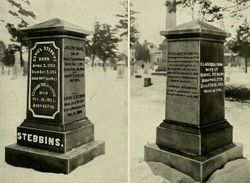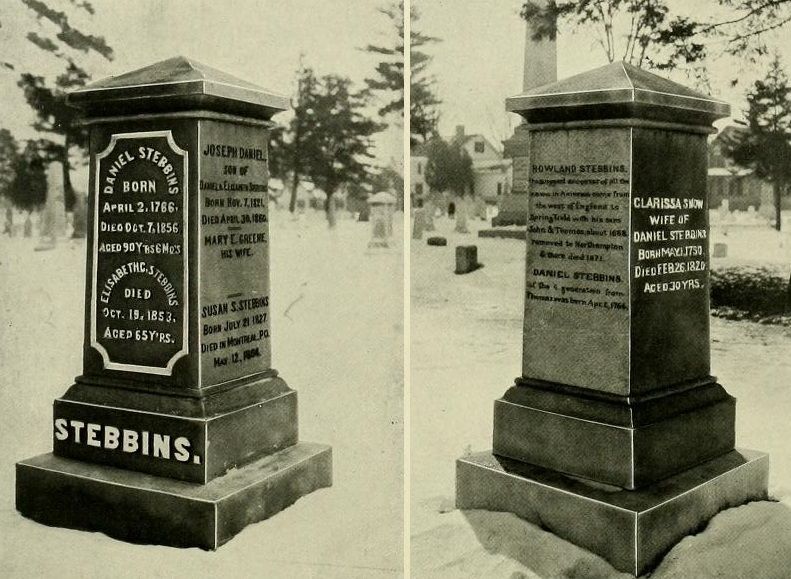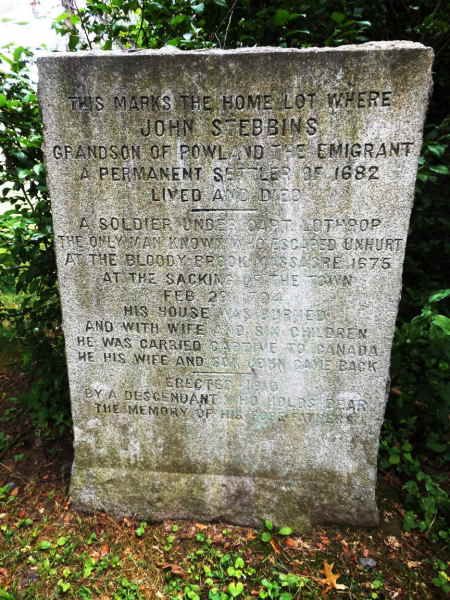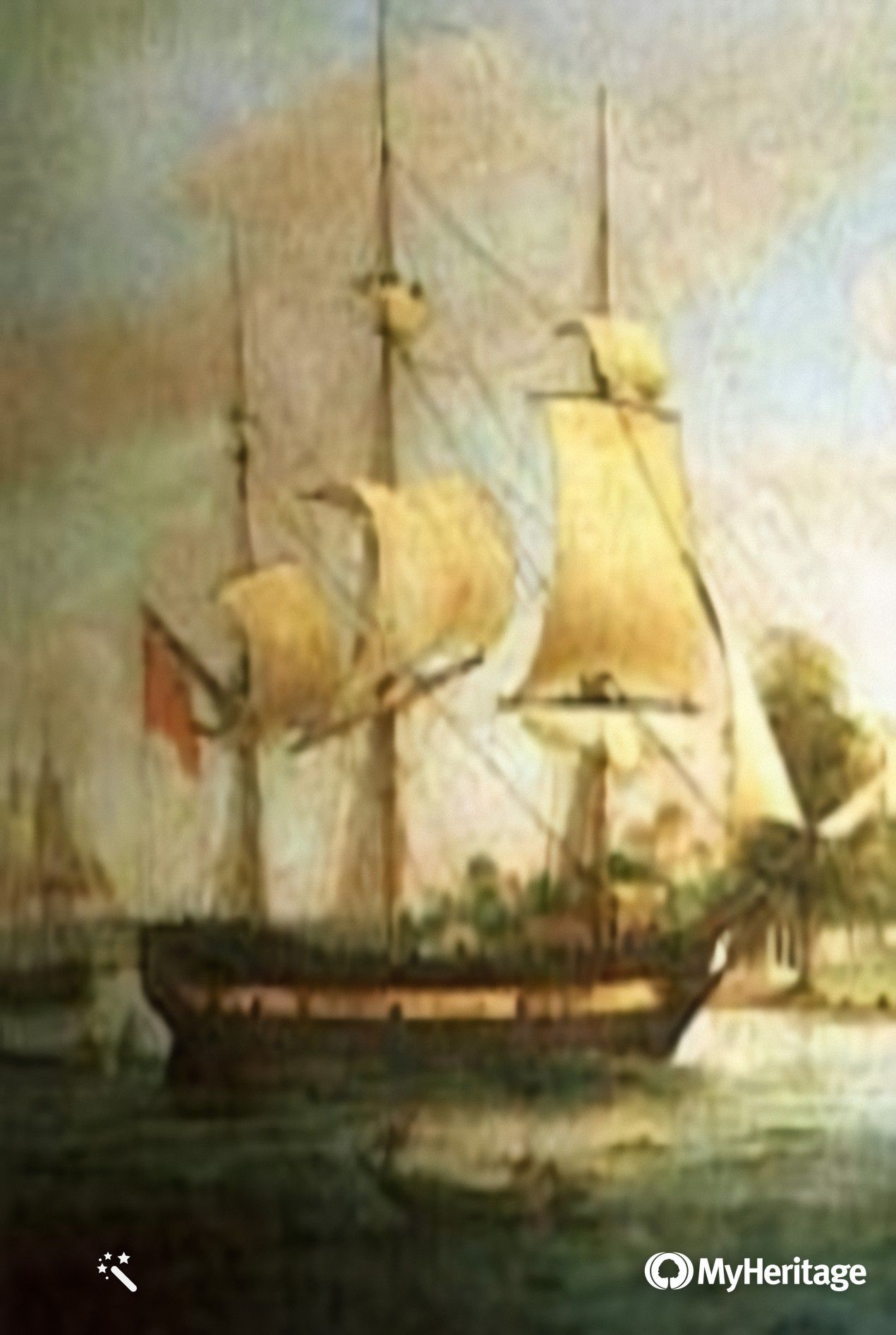His family left England, sailing out of the port of Ipswich, 30 April 1634, aboard The "Francis of Ipswich". Traveling were Rowland "Stebing" age 40, Sarah, his wife age 43, children: Thomas, age 14, Sarah, age 11, Elizabeth age 6 and John, age 8. Also traveling with the family is an unidentified 15 year old girl named Mary Winche.
Initially Rowland Stebbins settled in Roxbury, but in 1639 removed with his family to the newly settled (1636) Springfield, at the invitation of (it is said, and likely given later interactions) his good friend William Pynchon . It was in Springfield that his wife of 30 years, Sarah (Whiting) Stebbins died and was buried 5 Oct. 1649 in the old Elm Street burial ground (removed in it's entirety in 1848 to what is today Springfield Cemetery off Maple Street).
John Stebbins married:
First, at Springfield, 14 Mar. 1646, Ann (Munson) Munden, recent widow of Abraham Munden, who had drowned "at ye greate river at ye falls" along with William Jesse, 29 Oct. 1645. She was not (as has been published erroneously) the dau. of Thomas Munson of Hartford. She was b. England and likely resided Windsor at some point previous to her 1st marriage. She brought one child to the household, Mary Munden, born Springfield 1645. She and husband John Stebbins were actively involved in the Witchcraft accusations against Hugh & Mary Parsons of Springfield. Ann (Munson) Munden Stebbins died at Springfield in 1656 leaving three living children, two (John & Benoni) by John Stebbins.
Second, at Northampton, 17 Dec. 1657, Abigail, dau. of Robert & Ann (.....) Bartlett. John & Abigail appear in the Court at Northampton, 25 Sep. 1660 in a suit against Robert Lyman, who was accused of "frequentinge the said John Stebbins' house" "and did use very evil and unseemly behavior towards her, enticing her several times that he might ly with her, taking her in his arms and otherwise venting his unchaste desires" Lyman was found guilty, fined, and required to pay for the travel expenses of two witnesses. Abigail (Bartlett) Stebbins md. 2. 28 Dec. 1681 Jedidiah Strong.
Children: (by Ann Munson, born Springfield)
1. John b. 28 Jan. 1647
2. Thomas b.c. 1648 d. 24 Apr. 1649
3. Ann. b. 10 April 1651 d. aged 2 years
4. Edward b. 12 Jul. 1653
5. Benoni b. 23 Jun. 1655
Children: (by Abigail Bartlett, born Northampton)
6. Samuel b. 21 Jan. 1659
7. Abigail b. 24 Sep. 1660
8. Thomas b. 6 May 1662
9. Hannah b. 8 Jul. 1664
10. Mary b. 10 Sep. 1666
11. Sarah b. 4 Jun. 1668
12. Joseph b. 17 Jan. 1670
13. Deborah b. 5 Mar. 1672
14. Benjamin bap. 3 May 1674
15. Rebecca bap. 20 Feb. 1676
16. Thankful b. 11 May 1678
He purchased land and a home in Springfield in 1651, he was elected selectman there, 1654. After the death of his first wife Ann, John removed to Northampton with his father Rowland, where he became a prominent citizen, serving as selectman for nearly all of the period 1660-1678.
On August 28, 1668, he was permitted by a committee of land holders in "Paucomtucke"(Deerfield) to purchase from Lieut. John Fisher, land in the said place. On March 23, 1670 he was allotted 1 lot, 20 "cow commons" (roughly 7 acres) in size. In 1675, Indian tensions with colonists came to a boiling point and Deerfield was temporarily abandoned. He did not however, ever reside in that place, and is often mistakenly confused with his son John who did reside there, fought in (and was the only known survivor of) The Bloody Brook Massacre, and was eventually captured and carried to Canada with his family in 1704.
John Stebbins was also keeper of a sawmill, and (it is believed currently) that he was killed by some "runaway logs" 7 Mar. 1678-9. Some in the community suspected his death was the result of witchcraft.
*A twelve man jury of inquest rendered a verdict, which, while it did not directly charge witchcraft, showed that they more than half believed it had something to do with his death. Two examinations were of the remains and two reports were made to the court. In the first one, they declared that there was a "warmth and heate in his body that dead persons are not usual to have"; they reported that there were "fewer places upon his breast it seemed to have been pintched, though the doctor informed him that in his lifetime there was a swelling between the Pintches"; his neck was as flexible as that of a living person. Upon his body were found "several hundred of spots" that looked as if "they had been shott with small shott" and when they were scraped there were holes under them. On the second examination, which must have been made soon after the first one, they found, as would very naturally follow, "the body somewhat more cold yn before, his joints were more limber," and several bruises on different parts of his person which they had not previously discovered. The jury reported to the County Court in April, and Samuel Bartlett, brother-in-law to Stebbins, and who seems to have been the witch finder in general for the town, brought in all the testimony he could obtain. This evidence, which cannot be found now, was sent to the Court of Assistants at Boston, but no further action was taken.
________________
*details of the inquest into John Stebbins' death taken from "The Stebbins Genealogy. Ralph Stebbins Greenlee and Robert Lemuel Greenlee". Chicago, 1904
His family left England, sailing out of the port of Ipswich, 30 April 1634, aboard The "Francis of Ipswich". Traveling were Rowland "Stebing" age 40, Sarah, his wife age 43, children: Thomas, age 14, Sarah, age 11, Elizabeth age 6 and John, age 8. Also traveling with the family is an unidentified 15 year old girl named Mary Winche.
Initially Rowland Stebbins settled in Roxbury, but in 1639 removed with his family to the newly settled (1636) Springfield, at the invitation of (it is said, and likely given later interactions) his good friend William Pynchon . It was in Springfield that his wife of 30 years, Sarah (Whiting) Stebbins died and was buried 5 Oct. 1649 in the old Elm Street burial ground (removed in it's entirety in 1848 to what is today Springfield Cemetery off Maple Street).
John Stebbins married:
First, at Springfield, 14 Mar. 1646, Ann (Munson) Munden, recent widow of Abraham Munden, who had drowned "at ye greate river at ye falls" along with William Jesse, 29 Oct. 1645. She was not (as has been published erroneously) the dau. of Thomas Munson of Hartford. She was b. England and likely resided Windsor at some point previous to her 1st marriage. She brought one child to the household, Mary Munden, born Springfield 1645. She and husband John Stebbins were actively involved in the Witchcraft accusations against Hugh & Mary Parsons of Springfield. Ann (Munson) Munden Stebbins died at Springfield in 1656 leaving three living children, two (John & Benoni) by John Stebbins.
Second, at Northampton, 17 Dec. 1657, Abigail, dau. of Robert & Ann (.....) Bartlett. John & Abigail appear in the Court at Northampton, 25 Sep. 1660 in a suit against Robert Lyman, who was accused of "frequentinge the said John Stebbins' house" "and did use very evil and unseemly behavior towards her, enticing her several times that he might ly with her, taking her in his arms and otherwise venting his unchaste desires" Lyman was found guilty, fined, and required to pay for the travel expenses of two witnesses. Abigail (Bartlett) Stebbins md. 2. 28 Dec. 1681 Jedidiah Strong.
Children: (by Ann Munson, born Springfield)
1. John b. 28 Jan. 1647
2. Thomas b.c. 1648 d. 24 Apr. 1649
3. Ann. b. 10 April 1651 d. aged 2 years
4. Edward b. 12 Jul. 1653
5. Benoni b. 23 Jun. 1655
Children: (by Abigail Bartlett, born Northampton)
6. Samuel b. 21 Jan. 1659
7. Abigail b. 24 Sep. 1660
8. Thomas b. 6 May 1662
9. Hannah b. 8 Jul. 1664
10. Mary b. 10 Sep. 1666
11. Sarah b. 4 Jun. 1668
12. Joseph b. 17 Jan. 1670
13. Deborah b. 5 Mar. 1672
14. Benjamin bap. 3 May 1674
15. Rebecca bap. 20 Feb. 1676
16. Thankful b. 11 May 1678
He purchased land and a home in Springfield in 1651, he was elected selectman there, 1654. After the death of his first wife Ann, John removed to Northampton with his father Rowland, where he became a prominent citizen, serving as selectman for nearly all of the period 1660-1678.
On August 28, 1668, he was permitted by a committee of land holders in "Paucomtucke"(Deerfield) to purchase from Lieut. John Fisher, land in the said place. On March 23, 1670 he was allotted 1 lot, 20 "cow commons" (roughly 7 acres) in size. In 1675, Indian tensions with colonists came to a boiling point and Deerfield was temporarily abandoned. He did not however, ever reside in that place, and is often mistakenly confused with his son John who did reside there, fought in (and was the only known survivor of) The Bloody Brook Massacre, and was eventually captured and carried to Canada with his family in 1704.
John Stebbins was also keeper of a sawmill, and (it is believed currently) that he was killed by some "runaway logs" 7 Mar. 1678-9. Some in the community suspected his death was the result of witchcraft.
*A twelve man jury of inquest rendered a verdict, which, while it did not directly charge witchcraft, showed that they more than half believed it had something to do with his death. Two examinations were of the remains and two reports were made to the court. In the first one, they declared that there was a "warmth and heate in his body that dead persons are not usual to have"; they reported that there were "fewer places upon his breast it seemed to have been pintched, though the doctor informed him that in his lifetime there was a swelling between the Pintches"; his neck was as flexible as that of a living person. Upon his body were found "several hundred of spots" that looked as if "they had been shott with small shott" and when they were scraped there were holes under them. On the second examination, which must have been made soon after the first one, they found, as would very naturally follow, "the body somewhat more cold yn before, his joints were more limber," and several bruises on different parts of his person which they had not previously discovered. The jury reported to the County Court in April, and Samuel Bartlett, brother-in-law to Stebbins, and who seems to have been the witch finder in general for the town, brought in all the testimony he could obtain. This evidence, which cannot be found now, was sent to the Court of Assistants at Boston, but no further action was taken.
________________
*details of the inquest into John Stebbins' death taken from "The Stebbins Genealogy. Ralph Stebbins Greenlee and Robert Lemuel Greenlee". Chicago, 1904

















